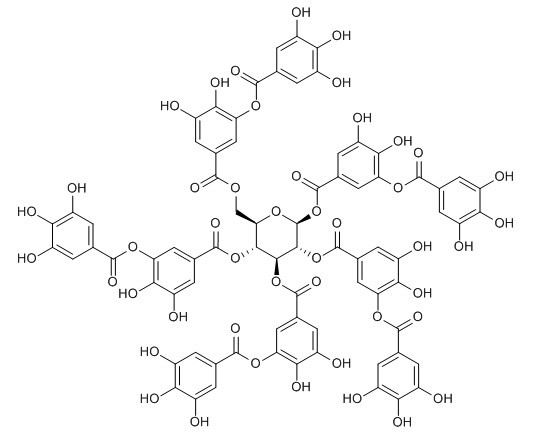Home
Products
Tannic acid



| Product Name | Tannic acid |
| Price: | $23 / 20mg |
| Catalog No.: | CN03886 |
| CAS No.: | 1401-55-4 |
| Molecular Formula: | C76H52O46 |
| Molecular Weight: | 1701.2 g/mol |
| Purity: | >=98% |
| Type of Compound: | Phenols |
| Physical Desc.: | Powder |
| Source: | The peels of Punica granatum L. |
| Solvent: | DMSO, Pyridine, Methanol, Ethanol, etc. |
| SMILES: | O=C(c1cc(O)c(c(c1)OC(=O)c1cc(O)c(c(c1)O)O)O)O[C@@H]1[C@@H](COC(=O)c2cc(O)c(c(c2)OC(=O)c2cc(O)c(c(c2)O)O)O)O[C@H]([C@@H]([C@H]1OC(=O)c1cc(O)c(c(c1)OC(=O)c1cc(O)c(c(c1)O)O)O)OC(=O)c1cc(O)c(c(c1)OC(=O)c1cc(O)c(c(c1)O)O)O)OC(=O)c1cc(O)c(c(c1)OC(=O)c1cc(O)c(c(c1)O)O)O |
| Contact us | |
|---|---|
| First Name: | |
| Last Name: | |
| E-mail: | |
| Question: | |
| Description | Tannic acid is a novel hERG channel blocker with IC50 of 3.4 μM. |
| Target | IC50: 3.4 μM (hERG channel)[1] |
| In Vivo | During the course of treatment, tannic acid significantly ameliorates these phenotypes in AD skin lesions. Tannic acid treatment aslo reduces these dermal changes compare with AD mice. Treatment with tannic acid increases PPARγ expression in AD skin sections. The PPARγ protein expression is suppressed in vehicle-treated AD mice, but when treats with tannic acid, its expression is increased dramatically. The IL-1β, TNFα, TNFR1, and COX2 protein expressions are significantly up-regulated in vehicle-treated AD mice, but significantly suppressed by tannic acid treatment[2]. |
| Animal Admin | Specific pathogen-free female 6 weeks old mice are used. The animals are maintained in a controlled room (temperature 23±2 °C, humidity 55±15%, 12 h light cycle). After 1 week, the mice arer andomly divided into 3 groups, untreated group-receive vehicle (distill water) (Normal, n=5); DfE cream treated mice (100 mg/mouse) is divided into two groups and each receives vehicle (distill water) (AD, n=5) or Tannic acid (80 mg/kg/day, per oral) (AD+Tannic acid, n=5) and are allowed free access to drinking water and standard laboratory diet[2]. |
| Density | 2.1±0.1 g/cm3 |
| Flash Point | 198°C |
| Exact Mass | 1700.172974 |
| PSA | 777.98000 |
| LogP | 13.33 |